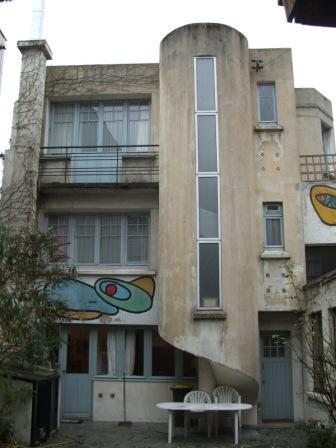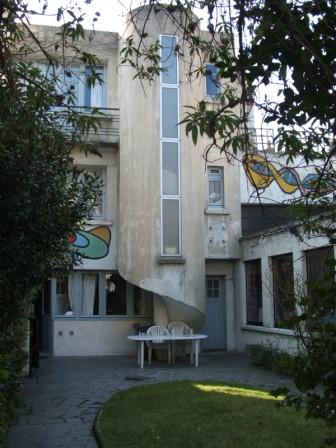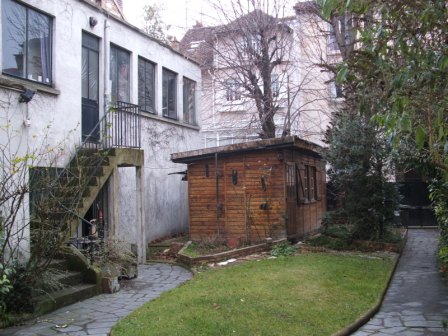HISTORY OF A HOUSE: The "17 Emile Dunois", Boulogne-Billancourt, France
by Isabel Peres Gomes
Marjorie and Frank Malina bought the 17 Emile Dunois, which had been built to be the studio and family home of a Portuguese sculptor, Ernesto Canto da Maia.

|
La maison en 1957 - The house in 1957
photo : Archives familiales Malina - Malina Family Private Archives |
Paris, artistic capital of the world in the XIX century, remained the mythical destiny for most young Portuguese artists in the first decades of the XX century. Born in the Açores Canto da Maia studied in Lisbon and continued his studies in Ecole des Beaux Arts in Paris and Switzerland. He returned to Lisbon were he became one of the promising artists of the modernistic movement. But Lisbon seemed too far away from what seemed to be happening in modern art. It's an enthusiastic Canto da Maia who decided to permanently leave for Paris writing to his friends that it is "la seule ville du monde où on peut véritablement mesurer sa valeur et puiser aux sources du passé et du présent, dans tout ce qu'ils ont de génial"

|
|

|
Le 17 rue Emile Dunois
Mars 2006 - Photos : Fabrice Lapelletrie |
Boulogne sur Seine also known as Boulogne-Billancourt, was, in the beginning of the XXth Century, a booming place. Industrial activity - the Renault factories, LTM telephone equipment, the cinema Studio Billancourt were installed in this socialist municipality. Innovative architectural and urbanistic experiments were being made by Perret, Tony Garnier, Mallet Stevens and Le Corbusier. Paul Marmottan gathered his collections there. Artists like Juan Gris, Vieira da Silva and Arpad Szcenes, the historian Salomon Reinach, the art dealer Henry Kahneweiler lived there and the tradition of opening their houses on Sundays, joining together writers, critics, the artistic vanguards was one that Frank Malina would recreate in the 1950's and 60's.
Several sculptors had installed there their ateliers, such as the Russian prince Toubetskoy, Joseph Berard, Landowski. Canto da Maia, Lipchitz, Imenitoff, Max Blondat were some of the younger artists who settled in Boulogne after the war. Canto da Maia lived in Boulogne from 1923, having bought sculptor Landowski's old atelier. Later he built no.17, where he never actually lived, as he separated from his wife Mathilde soon after construction was completed. He remained living in Boulogne until, participating with success in the Parisian artistic scene. In his work, the stylisation and elegance of decorative arts are used to express his particular kind of delicate, melancholic intimacy. Canto da Maia returned to Portugal in 1938. Matilde and his children remained in the no. 17 until it was sold to Marjorie and Frank in 1954.

|
|

|
Le 17 rue Emile Dunois
Mars 2006 - Photos : Fabrice Lapelletrie |
.
|









